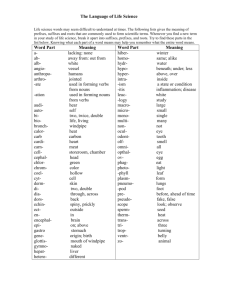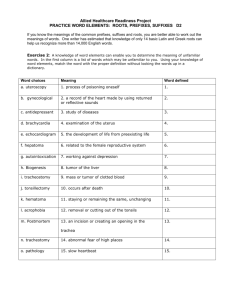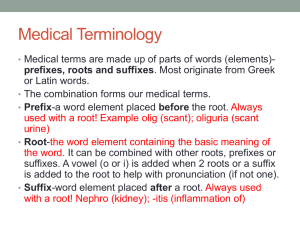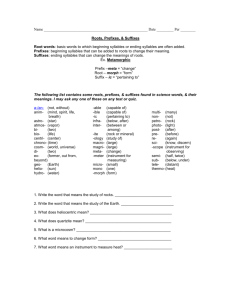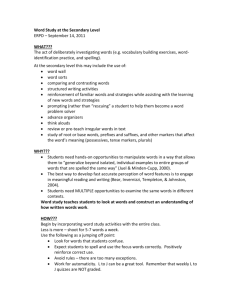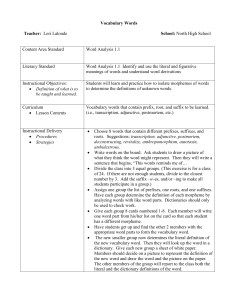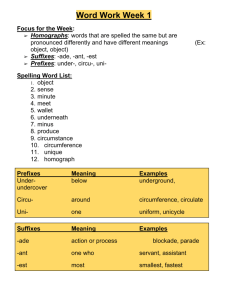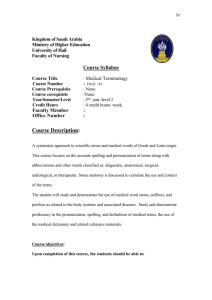Medical Terminology - lifestyle
advertisement
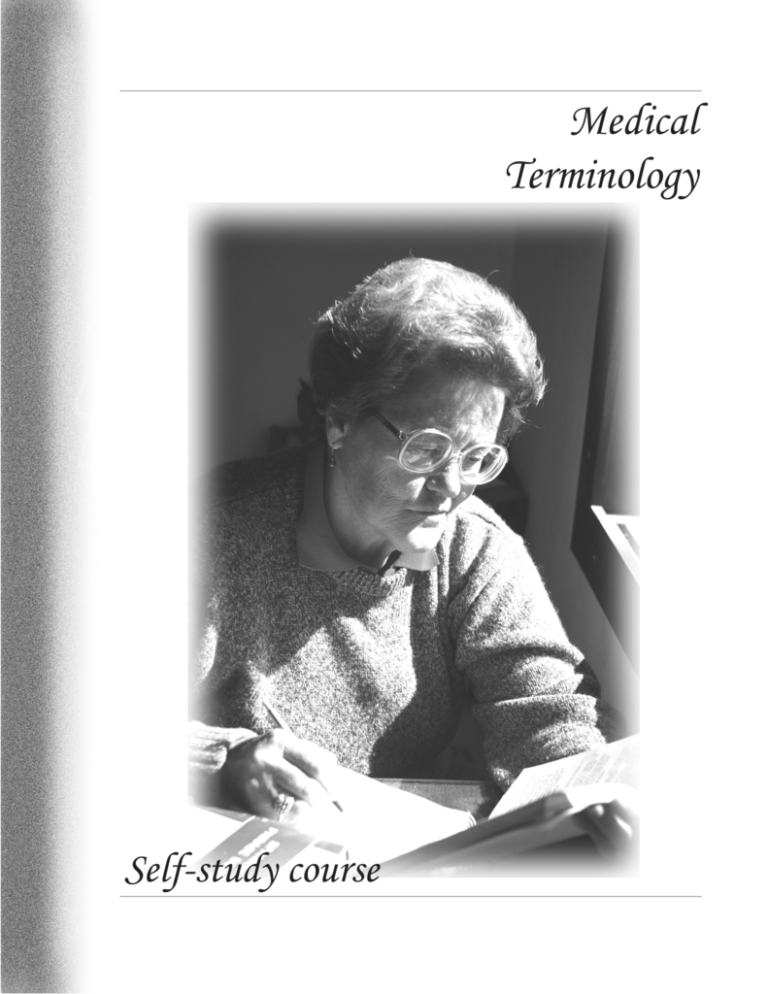
Medical Terminology Self-study course Course objectives At the end of this course you will be able to: 1) Identify three benefits of knowing medical terminology 2) Identify five medical words, terms or symbols used in documentation 3) Identify five medical words, terms or symbols that might be used in an order Medical terminology You probably think medical terms are long unpronounceable words that only doctors and nurses can understand. This is not true! People use medical terms every day. We commonly used medical terms such as: flu, pneumonia, cancer, and cardiac disease. With a little bit of practice you too can understand the world of medical terminology. The words, terms or symbols that make up the language of medicine are referred to as medical terminology. Like every other language, medical terminology has changed over time, but the majority of terms are based in Latin or Greek. Most terms can be broken down into one or more word parts. In medical terminology there are three possible word parts. Any given medical term may contain one, some or all of these parts. The three parts are: 1) prefixes 2) roots 3) suffixes Prefixes A prefix is a word segment placed at the beginning of a word. A prefix helps to change or define the meaning of the word. Prefixes are always combined with other word segments. They are never used alone. Here are a few examples of common prefixes and what they mean. anti — against semi — half brady — slow tachy — fast/rapid hemi — half dys — difficult/labored/painful hypo — below/deficient hyper — above/excessive poly — many mal — bad Roots The root of a word contains its basic meaning. It is combined with another root, with prefixes and with suffixes in various combinations to form a medical term. A vowel is added when two roots are combined or when a suffix is added to a root. The vowel is called a combining vowel and is usually an “o.” An “i” is sometimes used when there is no vowel between the two combined roots or between the root and the suffix. A combining vowel makes pronunciation easier. Here are a few examples of common roots and what they mean. bronch — bronchus pseudo — false/fake cardi — heart therm — heat gastr — stomach thromb — clot glycos — sugar thyroid — thyroid gland nephr — kidney urin — urine/urinary tract Suffixes A suffix is placed at the end of a root to also change or help define the meaning of the word. Suffixes are not used alone. Like prefixes and roots they are from Greek or Latin. Here are a few examples of suffixes and what they mean: ectomy — excision or surgical removal emia — blood condition ism — state of itis — inflammation of ology — study of ostomy — creating of an artificial opening plegia — paralysis pnea — breathing thorax — chest Making words Medical terms are formed by combining word segments. A root can be combined with prefixes, roots or suffixes. For example, the prefix dys (difficult) can be combined with the root pnea (breathing). This forms the term dyspnea meaning difficulty in breathing. Roots can be combined with suffixes. The root mast (breast) combined with the suffix ectomy (excision or removal) forms the term mastectomy. It means removal of a breast. Combining a prefix, root, and suffix is another way to form medical terms. Endocarditis consists of the prefix endo (inner), the root card (heart), and the suffix itis (inflammation). Endocarditis means inflammation of the inner part of the heart. The important things to remember are that prefixes always come before roots and suffixes always come after roots. Some people find it easier to begin with the suffixes when translating medical terms. For example, itis means inflammation so just by looking at the word we know we are talking about an inflammation somewhere. Why learn medical terminology? During the course of our day to day work we come across many words, terms and symbols. These words, terms and symbols make up what is called medical terminology. Today’s medical terms have their basis in either Latin or Greek so not all of the terms/words will make sense. For example, NPO stands for Nil Per Os or nothing by mouth. As a member of the health care team you need to know what these words, terms and symbols mean. You will see them written in diagnoses, medication orders and you will use them as part of your every day documentation. The benefits of learning medical terminology include: 1) being able to communicate better with other health care team members, 2) being able to carry out orders and instructions correctly 3) improving the quality of your documentation Let’s now discuss these three distinct areas. Some of the medical terms may be used in more than one area. Communicating with the health care team When communication occurs with other health care team members, medical terms are used on a regular basis to convey a lot of information without having to use a lot of words. For example, the acronym COPD stands for Chronic Obstructive Pulmonary Disease. As you can see it is easier to say “the patient has COPD” then to say “the patient has chronic obstructive pulmonary disease.” You are communicating the same information but in a lot less time. The following is a list of common medical terms used when communicating verbally with members of the health care team. This is not an all-inclusive list — just a listing of some common terms. A Fib — atrial fibrillation DOB — date of birth AMA — against medical advice ECG/EKG — electrocardiogram ASHD — arteriosclerotic heart disease ER — emergency room BM — bowel movement GI — gastrointestinal BP — blood pressure H& P — history and physical CAD — coronary artery disease HMO — health maintenance organization CBC — complete blood count CHF — congestive heart failure CNS — central nervous system IV — intravenous COPD — chronic obstructive pulmonary disease LOC — level of consciousness MD — medical doctor CP — cerebral palsy MI — myocardial infarction CPR — cardiopulmonary resuscitation MR — mental retardation CVA — cerebrovascular accident MS — multiple sclerosis D/C — discontinue NGT — nasogastric tube DD — developmentally delayed NPO — Nil Per Os (nothing by mouth) DKA — diabetic ketoacidosis DNR — do not resuscitate IM — intramuscular O2 — oxygen OD — overdose OT — occupational therapy SOB — shortness of breath PCP — primary care physician TB — tuberculosis PE — pulmonary edema TIA — transient ischemic attack PEG — percutaneous endoscopic gastrostomy (gastric tube) (GI tube) TPN — total parental nutrition PT — physical therapy TPR — temperature, pulse, respiration RBC — red blood cell URI — upper respiratory infection Rx — prescription UTI — urinary tract infection Practice You are a care provider considering whether to accept the following resident. The person making the inquiry is stating the resident has the following diagnoses; A fib, ASHD, CHF and COPD. The H&P does not indicate any behavior problems. The patient does have a DNR order. They will be admitted from the ER with an NGT. The MD will be looking to see if the person has a possible UTI. Define the following words: AMA_____________________________ H&P______________________________ ASHD____________________________ DNR_ ____________________________ CHF______________________________ NGT______________________________ COPD____________________________ UTI_ _____________________________ Medical orders Another place where we see different medical words, terms and symbols is in medical orders. These orders can range from how and when a medication is to be given to how often an ordered treatment is to be performed. It is especially important that we understand what these medical words, terms and symbols mean because not following orders could have negative consequences for the people in our care. This is not an all inclusive list. ac — before meals AMA — against medical advice am — morning amt — amount ASA — acetylsalicylic acid (aspirin) BID — Bis In Die (twice a day) BM — bowel movement BP — blood pressure BS — bowel sounds c — with caps — capsules cc — cubic centimeter CP — chest pain D/C — discharge DC — discontinue DNR — do not resuscitate Dx — diagnosis F/U — follow up FBS — fasting blood sugar Fx — fracture FYI — for your information gtts — drops H&P — history and physical hr — hour HTN — hypertension Hx — history I&O — intake and output IM — intramuscular IV — intravenous liq — liquid pt — patient LPM — liters per minute PT — physical therapy meds — medications Q — every mid noc — midnight QD — each day min — minute QH — every hour ml — milliliter Q2H — every two hours mEq — milliequivalent Q3H — every three hours MD — medical doctor QHS — every night at bedtime noc — night QID — Quarter In Die (4 times a day) NPO — Nil Per Os (nothing by mouth) QOD — every other day NSAID — non-steriodal antiinflammatory drug NTG — nitroglycerin N/V — nausea/vomiting NC — nasal cannula NGT — nasogastric tube Rx — prescription s — without SOB — shortness of breath stat — immediately SQ — subcutaneous tabs — tablets NKDA — no known drug allergies OTC — over the counter O2 — oxygen oz — ounce pc — after meals per — by/through pm — afternoon PCN — penicillin PEG — percutaneous endoscopic gastrostomy (gastric tube) PO — Per Os (by mouth) PRN — Pro Re Nata (as necessary) Continued on page 10 TB — tuberculosis tbsp — tablespoon tsp — teaspoon TIA — transient ischemic attack TID — three times a day TX — treatment UA — urine analysis URI — upper respiratory infection UTI — urinary tract infection VS — vital signs w/ — with w/o — without w/c — wheelchair wt — weight x — times Practice Translate the following orders: Ambien one tab po QHS_ _______________________________________________ Zantac one tab BID_____________________________________________________ Reglan 1 tab ac TID_____________________________________________________ NPO after mid noc_ ____________________________________________________ Tylenol 2 tabs Q4hrs PRN_______________________________________________ DC previous orders_ ___________________________________________________ 10 Documentation Documentation is one of the most important tasks a caregiver will complete on a regular basis. It is in your documentation where you show what care and services were given, what the person’s response to those care and services were, progress or lack of progress, assessment of problems, evaluations of goals, teaching etc. Documentation is a form of communication when other members of the health care team visit to review a person’s progress. Because documentation is so vital, it is important that your documentation be accurate, objective and concise. The use of standardized medical words, terms and symbols will help you convey what has been happening in the least amount of words. There are going to be times when you may need to be more descriptive than the following words, terms and symbols. Medical terminology should never be used as a substitute for complete documentation. Your documentation should include whatever words, terms, or symbols are needed to ensure your documentation is complete and accurate. CA — cancer A/O — alert and oriented CAD — coronary artery disease ADL — activities of daily living CBC — complete blood count ac — before meals CHF — congestive heart failure ad lib — as desired CNS — central nervous system AM — morning c/o — complains of AMT — amount COPD — chronic obstructive AMA — against medical advice pulmonary disease ASA — acetylsalicylic acid (aspirin) CP — cerebral palsy ASHD — arteriosclerotic heart disease CP — chest pain BID — Bis In Die (twice a day) CPR — cardiopulmonary resuscitation BM — bowel movement BP — blood pressure BS — bowel sounds c — with DC — discontinue CVA — cerebrovascular accident (stroke) CXR — chest x-ray Continued on page 12 11 DNR — do not resuscitate MR — mental retardation DOB — date of birth mos — month DR — doctor neg — negative drsg — dressing noc — night Dx — diagnosis N/V — nausea/vomiting ECG — electrocardiogram NGT — nasogastric tube ER — emergency room NKDA — no known drug allergies ETOH — alcohol NPO — Nil Per Os (nothing by mouth) FBS — fasting blood sugar F/U — follow up Fx — fracture GI — gastrointestinal H&P — history and physical hr — hour HS — hour of sleep HTN — hypertension Hx — history I&O — intake and output 12 NTG — nitroglycerin O2 — oxygen OT — occupational therapy pc — after meals per — by/through PEG — percutaneous endoscopic gastrostomy (gastric tube) pm — afternoon PO — Per Os (by mouth) IM — intramuscular POLST — physician’s orders for life sustaining treatment IV — intravenous PRN — Pro Re Nata (as necessary) lab — laboratory PT — physical therapy LOC — level of consciousness pt — patient LTC — long-term care Q — every meds — medications QD — each day mid noc — midnight QH — every hour min — minute Q2H — every 2 hours MD — medical doctor Q3H — every 3 hours MI — myocardial infarction QID — Quarter In Die (4 times a day) QHS — every night at bedtime QOD — every other day ROM — range of motion Rx — prescription s — without S/S — signs and symptoms tsp — teaspoon TX — treatment U/A — urinary analysis URI — upper respiratory infection UTI — urinary tract infection SOB — shortness of breath VS — vital signs stat — immediately W/ — with Sx — symptoms W/O — without tbsp — tablespoon W/C — wheelchair TB — tuberculosis WNL — within normal limits TIA — transient ischemic attack TID — three times a day TPN — total parenteral nutrition TPR — temperature, pulse, respiration WT — weight X — times Y/O — year old Practice Translate the following entry: James W. is a 26 y/o A/O male with a Dx of CP who was admitted to room 3a from the ER at Valley Hospital. He will be here short term for a F/U with PT for a Fx of his rt leg. His past medical Hx is clear for any other major illnesses except for those associated with his CP. He has NKDA. So far has adjusted well to the facility and c/o not having younger males around to talk to. Is up and about ad lib. Up in w/c daily. VS stable. Helen Helpful 13 Final note Medical terminology is a useful tool to communicate with other members of the health care team. It is not a substitute for good communication. It is a tool to aid you only. As a caregiver, it is your responsibility to always clarify any orders or documentation you do not understand. Answers to practice questions Page 7 — AMA = against medical advice ASHD = arteriosclerotic heart disease CHF = congestive heart failure COPD = chronic obstructive pulmonary disease H & P = history and physical DNR = do not resuscitate NGT = nasogastric tube UTI = urinary tract infection Page 10 — Ambien one tablet by mouth at bedtime Zantac one tablet twice a day Reglan one tablet before meals three times a day nothing by mouth after midnight Tylenol 2 tablets every 4 hours as requested Discontinue previous orders Page 13 — James W. is a 26 year old alert and oriented male with a diagnosis of cerebral palsy who was admitted to Room 3a from the emergency room at Valley H ospital He will be here short term for a follow up with physical therapy for a fracture of his right leg. His past medical history is clear for any other major illnesses except for 14 those associated with his cerebral palsy. He has no known drug allergies. So far has adjusted well to the facility and complains of not having younger males around to talk to. Is up and about as he desires. Up in wheelchair daily. Vital signs stable. Helen Helpful 15 This publication is available in alternate formats. Call 1‑800‑282-8096 V/TTY Oregon Department of Human Services Seniors and People with Disabilities 500 Summer St. NE, E13 Salem, Oregon 97301-1073 Phone: 1-800-232-3020 V/TTY V/TTY: 503-945-5811 Fax: 503-378-8966
